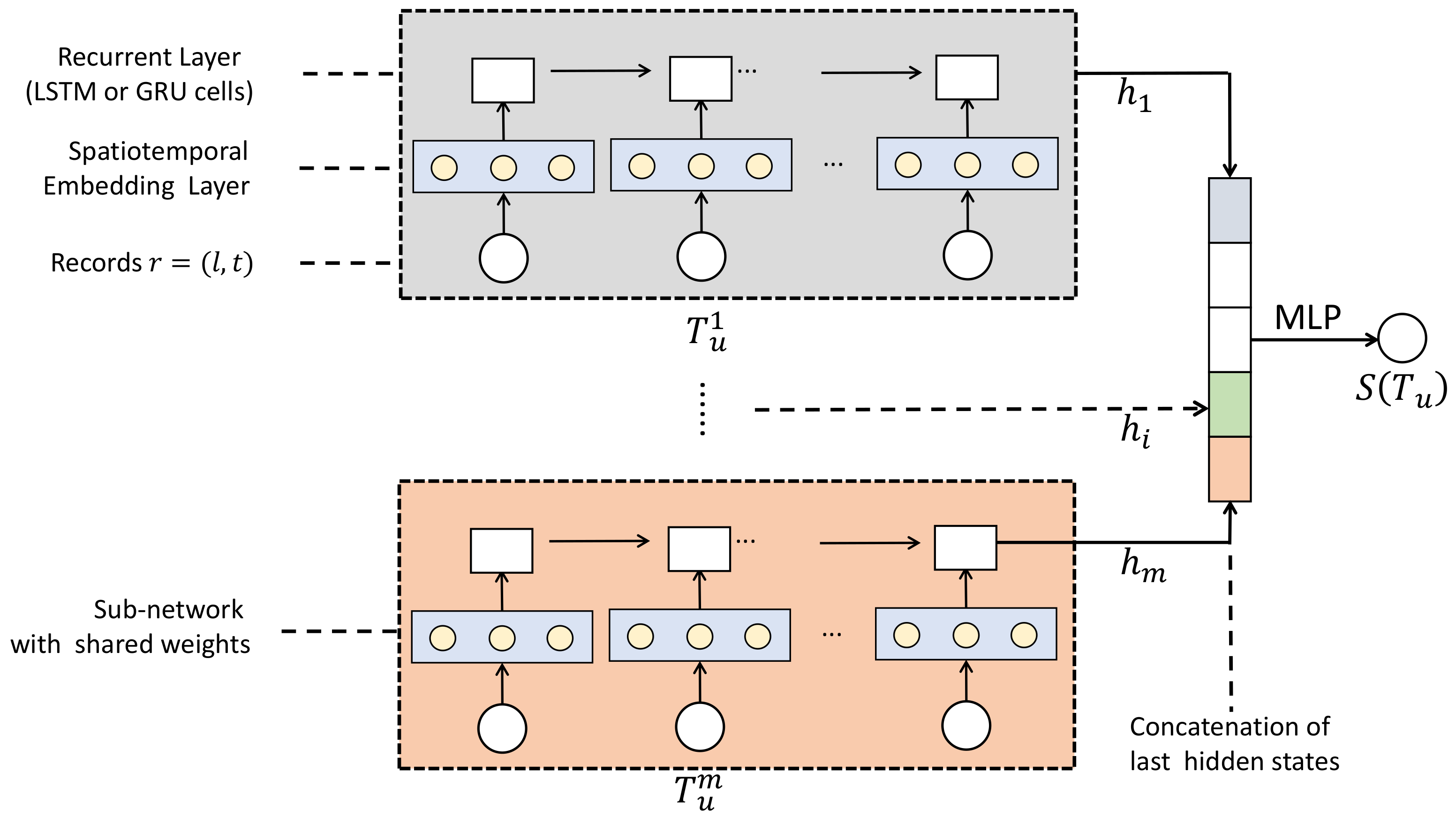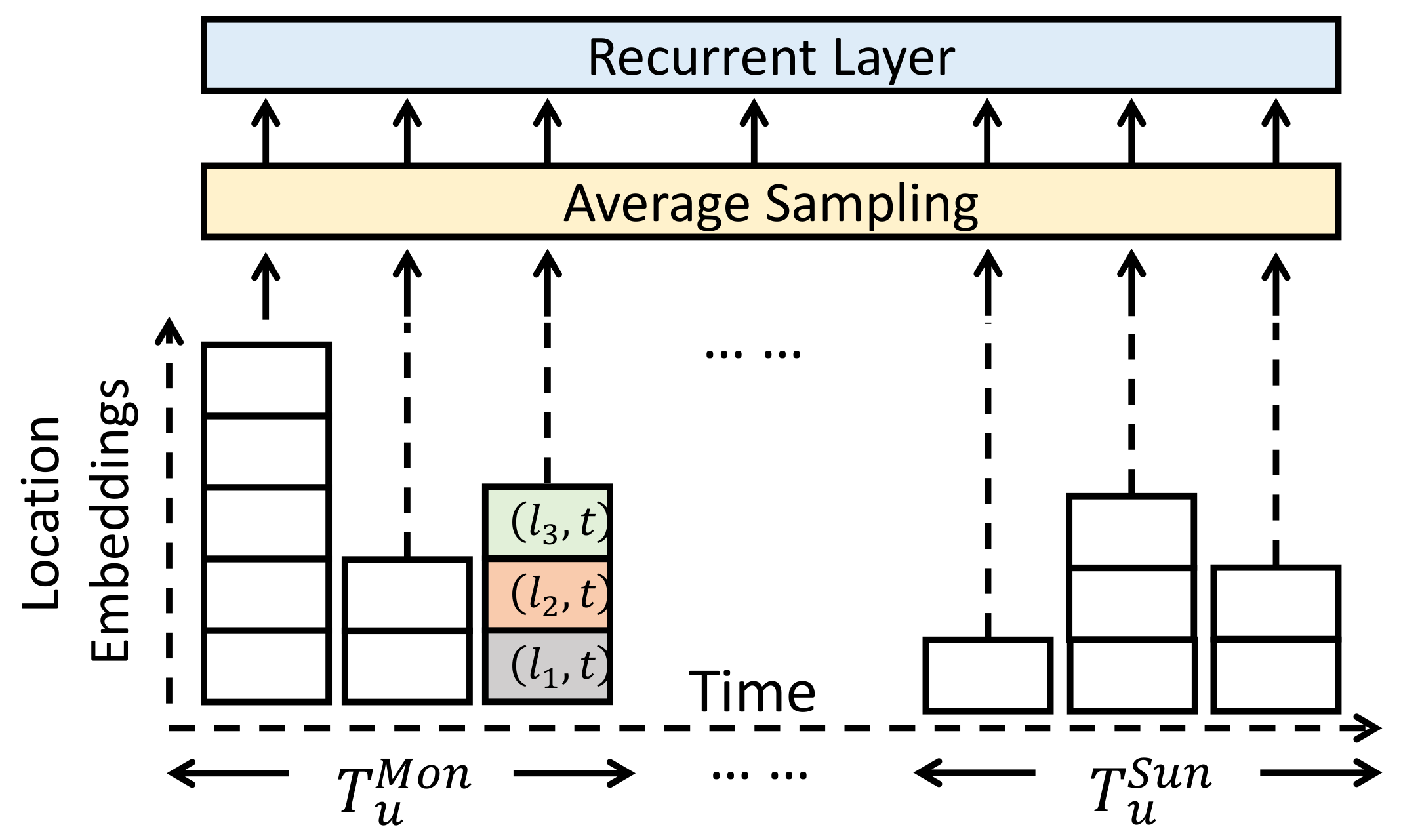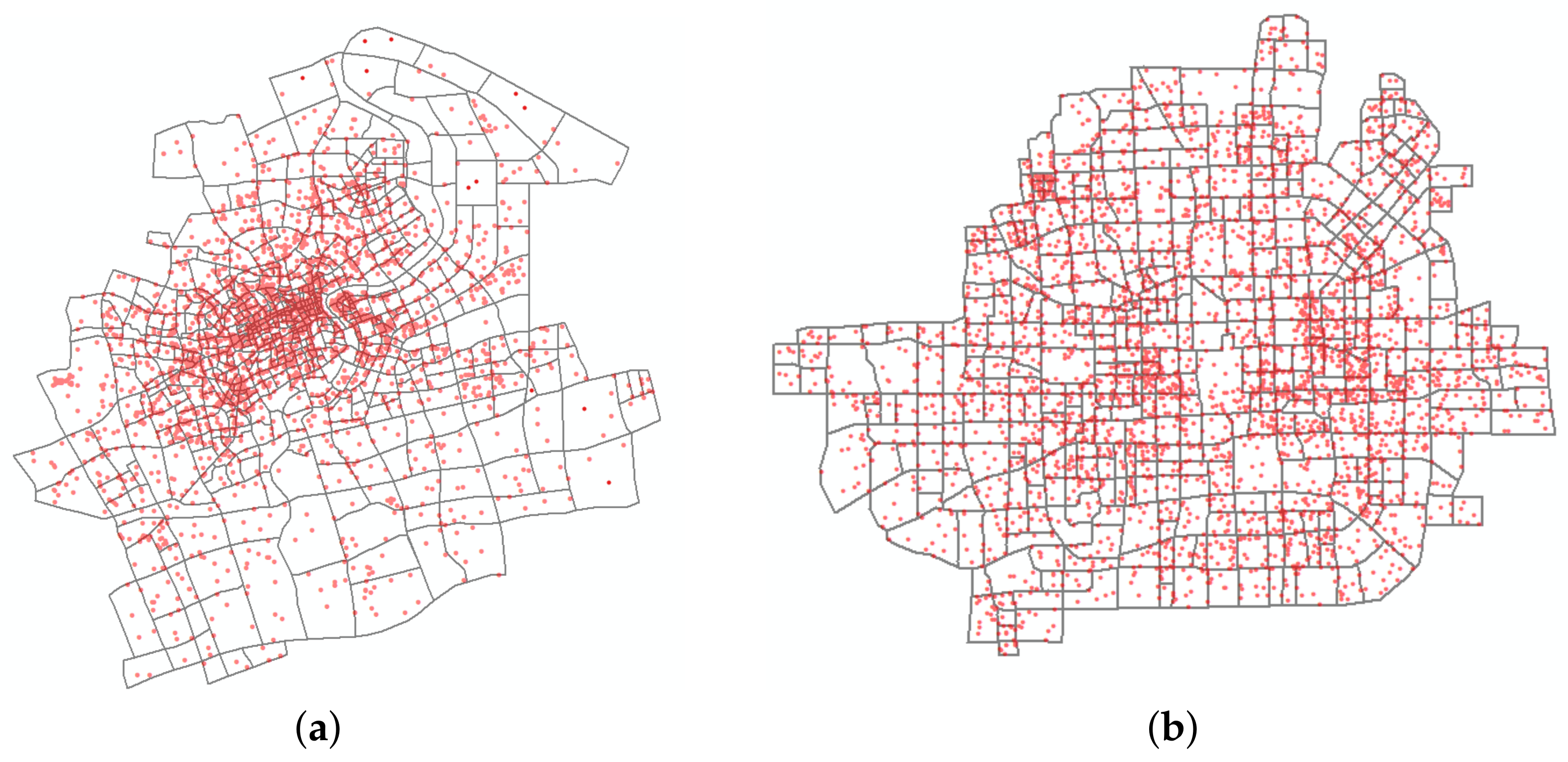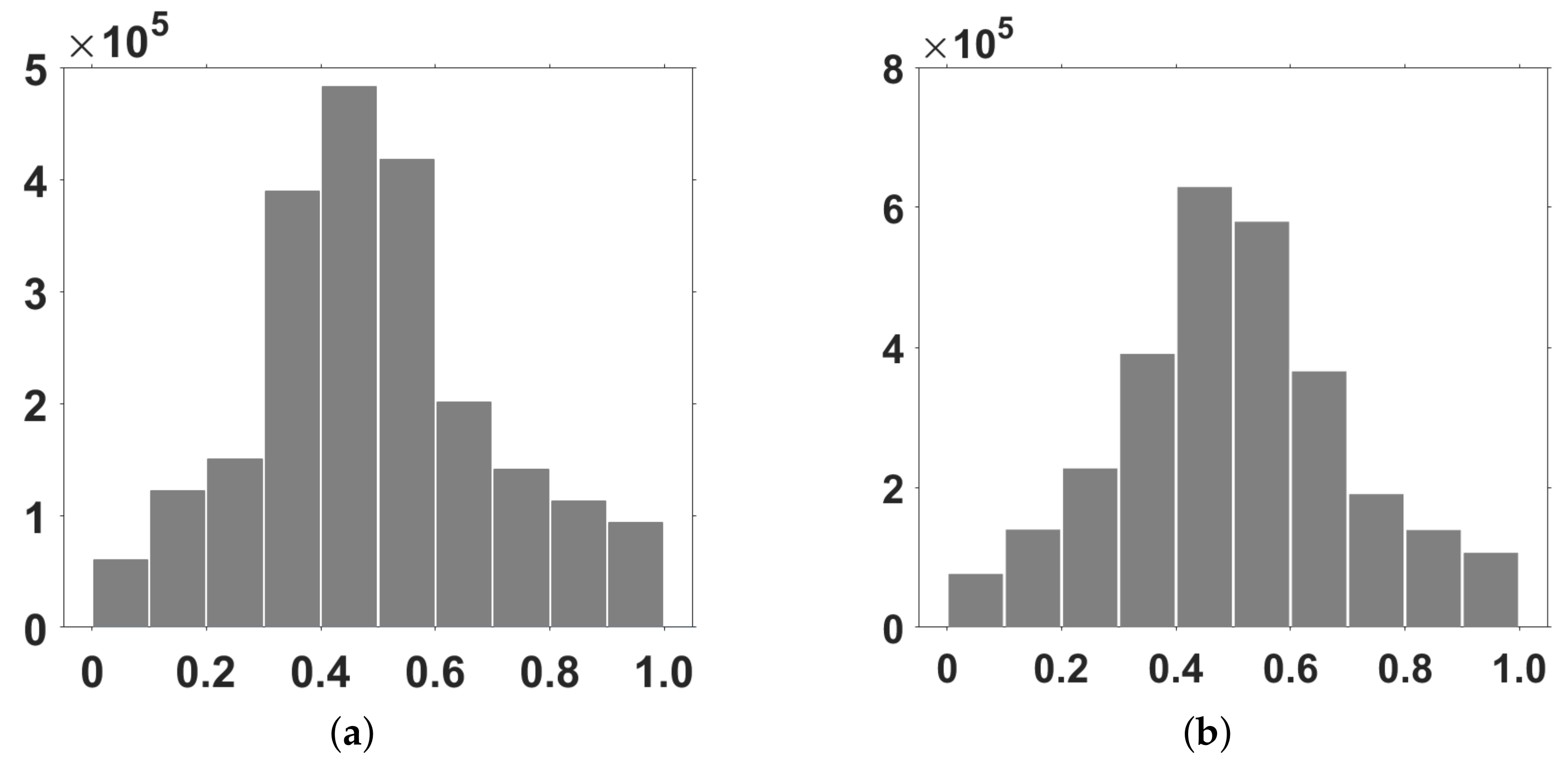Human Mobility Prediction with Calibration for Noisy Trajectories
Abstract
1. Introduction
- We propose a calibration framework for mobility prediction based on the instance-weighting strategy to automatically evaluate the quality of training trajectories and differentiate their impact on the training process of the mobility prediction model. To the best of our knowledge, we are the first to explore mobility prediction problems on massive noisy data through an instance-weighting method.
- We employ an unsupervised method to estimate the parameters of the proposed calibration network, which liberates human energy on label tagging and makes it possible to apply the network to massive citywide mobility data. Additionally, the proposed approach is model-independent and can be combined with any massive data-driven neural prediction network.
- We conducted our experiments on citywide cellular network datasets collected from two metropolises that covered more than two million people, respectively. The experimental results show that evaluating the quality of user trajectories and calibrating the training process can effectively improve the performance of neural prediction models.
2. Related Work
2.1. Mobility Prediction
2.2. Instance Weighting
3. Materials & Methods
3.1. Preliminaries
3.2. Calibration Network
3.3. Parameter Estimation
3.4. Instance Weighting
3.5. Dataset
3.6. Data Selection
4. Results
4.1. Baselines and Metrics
- Markov Chain—A Markov Chain is used to predict human mobility for a long time. It regards the visited locations as states and builds a transition matrix to capture the first-order transition probabilities between them. A Markov Chain is unsuitable for adopting the instance-weighting strategy as it owns a different process of parameter updates.
- PMM—The Periodic Mobility Model (PMM) [3] assumes that mobility trajectories follow a spatio-temporal mixture model and predict the next locations with periodicity taken into consideration. Like the Markov Chain, PMM is essentially a two-state mixture of Gaussians with a time-dependent state prior and is not adaptive for a combination of the calibration model.
- RNN—ST-RNN is a popular recurrent model in location prediction, which focuses on modeling the continuous spatio-temporal information within the framework of RNN. Here, we adopt a variant ST-RNN (RNN in short) to our scene where only anonymous location ID is known instead of detailed geographic information.
- DeepTransport—The deep learning module of DeepTransport [53] can be regarded as a multi-layer LSTM network: two hidden layers share the same parameters to capture the long-term temporal dependency of human mobility and transportation patterns, along with one encoding layer for separated input sequence and one decoding layer for separated output sequences. LSTM is kept for the basic recurrent module of DeepTransport as the design in the original version.
- DeepMove—DeepMove is the first historical attention method for learning human mobility from current and historical trajectories. It can be considered a complex version of baseline RNN with a historical attention module.
4.2. Experimental Results
5. Discussion
Author Contributions
Funding
Informed Consent Statement
Conflicts of Interest
Abbreviations
| RNN | Recurrent Neural Networks |
| LSTM | Long Short-Term Memory |
| GRU | Gate Recurrent Unit |
| GPU | Graphic Processing Unit |
| POI | Point of Interest |
| PRME | Personalized Ranking Metric Embedding |
| ST-RNN | Spatial Temporal Recurrent Neural Networks |
| HSMM | Hidden Semi-Markov Model |
| HMM | Hidden Markov Model |
| BiLSTM-CNN | Bidirectional Long Short-Term Memory–Convolutional Neural Network |
| DWSTTN | Deep Wide Spatio-Temporal Transformer Network |
| GCDAN | Graph Convolutional Dual-Attentive Networks |
| PMM | Periodic Mobility Model |
References
- Song, C.; Qu, Z.; Blumm, N.; Barabási, A.L. Limits of predictability in human mobility. Science 2010, 327, 1018–1021. [Google Scholar] [CrossRef]
- Lu, X.; Wetter, E.; Bharti, N.; Tatem, A.J.; Bengtsson, L. Approaching the limit of predictability in human mobility. Sci. Rep. 2013, 3, 2923. [Google Scholar] [CrossRef] [PubMed]
- Cho, E.; Myers, S.A.; Leskovec, J. Friendship and mobility: User movement in location-based social networks. In Proceedings of the 17th ACM SIGKDD International Conference on Knowledge Discovery and Data Mining, San Diego, CA, USA, 21–24 August 2011; pp. 1082–1090. [Google Scholar] [CrossRef]
- Mathew, W.; Raposo, R.; Martins, B. Predicting future locations with hidden Markov models. In Proceedings of the 2012 ACM Conference on Ubiquitous Computing, Pittsburgh, PA, USA, 5–8 September 2012; pp. 911–918. [Google Scholar] [CrossRef]
- Yan, M.; Li, S.; Chan, C.A.; Shen, Y.; Yu, Y. Mobility Prediction Using a Weighted Markov Model Based on Mobile User Classification. Sensors 2021, 21, 1740. [Google Scholar] [CrossRef]
- Wang, H.; Li, Y.; Jin, D.; Han, Z. Attentional Markov Model for Human Mobility Prediction. IEEE J. Sel. Areas Commun. 2021, 39, 2213–2225. [Google Scholar] [CrossRef]
- Ma, Z.; Rana, P.K.; Taghia, J.; Flierl, M.; Leijon, A. Bayesian estimation of Dirichlet mixture model with variational inference. Pattern Recognit. 2014, 47, 3143–3157. [Google Scholar] [CrossRef]
- Lipton, Z.C.; Berkowitz, J.; Elkan, C. A critical review of recurrent neural networks for sequence learning. arXiv, 2015; arXiv:1506.00019. [Google Scholar]
- Vaswani, A.; Shazeer, N.; Parmar, N.; Uszkoreit, J.; Jones, L.; Gomez, A.N.; Kaiser, Ł.; Polosukhin, I. Attention is all you need. In Proceedings of the 31st Conference on Neural Information Processing Systems (NIPS 2017), Long Beach, CA, USA, 4–9 December 2017. [Google Scholar]
- Liu, Q.; Wu, S.; Wang, L.; Tan, T. Predicting the next location: A recurrent model with spatial and temporal contexts. In Proceedings of the Thirtieth AAAI Conference on Artificial Intelligence, Phoenix, AZ, USA, 12–17 February 2016. [Google Scholar]
- Feng, J.; Li, Y.; Zhang, C.; Sun, F.; Meng, F.; Guo, A.; Jin, D. Deepmove: Predicting human mobility with attentional recurrent networks. In Proceedings of the 2018 World Wide Web Conference, Lyon, France, 23–27 April 2018; pp. 1459–1468. [Google Scholar] [CrossRef]
- Dang, W.; Wang, H.; Pan, S.; Zhang, P.; Zhou, C.; Chen, X.; Wang, J. Predicting Human Mobility via Graph Convolutional Dual-attentive Networks. In Proceedings of the Fifteenth ACM International Conference on Web Search and Data Mining, Houston, Texas, USA, 21–25 February 2022; pp. 192–200. [Google Scholar] [CrossRef]
- Wang, H.; Yu, Q.; Liu, Y.; Jin, D.; Li, Y. Spatio-Temporal Urban Knowledge Graph Enabled Mobility Prediction. Proc. ACM Interact. Mob. Wearable Ubiquitous Technol. 2021, 5, 1–24. [Google Scholar] [CrossRef]
- Jang, H.S.; Baek, J.H. Mobility Management Scheme with Mobility Prediction in Wireless Communication Networks. Appl. Sci. 2022, 12, 1252. [Google Scholar] [CrossRef]
- Qi, L.; Qiao, Y.; Abdesslem, F.B.; Ma, Z.; Yang, J. Oscillation resolution for massive cell phone traffic data. In Proceedings of the First Workshop on Mobile Data, Porto, Portugal, 13–16 June 2016; pp. 25–30. [Google Scholar] [CrossRef]
- Bayir, M.A.; Demirbas, M.; Eagle, N. Mobility profiler: A framework for discovering mobility profiles of cell phone users. Pervasive Mob. Comput. 2010, 6, 435–454. [Google Scholar] [CrossRef]
- Calabrese, F.; Di Lorenzo, G.; Liu, L.; Ratti, C. Estimating origin-destination flows using mobile phone location data. In Proceedings of the IEEE Pervasive Computing, Seattle, WA, USA, 21–25 March 2011; pp. 36–44. [Google Scholar]
- Wu, W.; Wang, Y.; Gomes, J.B.; Anh, D.T.; Antonatos, S.; Xue, M.; Yang, P.; Yap, G.E.; Li, X.; Krishnaswamy, S.; et al. Oscillation resolution for mobile phone cellular tower data to enable mobility modelling. In Proceedings of the 2014 IEEE 15th International Conference on Mobile Data Management, Brisbane, QLD, Australia, 15–18 July 2014; Volume 1, pp. 321–328. [Google Scholar] [CrossRef]
- Wang, F.; Chen, C. On data processing required to derive mobility patterns from passively-generated mobile phone data. Transp. Res. Part C Emerg. Technol. 2018, 87, 58–74. [Google Scholar] [CrossRef]
- Xu, Y.; Li, X.; Shaw, S.L.; Lu, F.; Yin, L.; Chen, B.Y. Effects of Data Preprocessing Methods on Addressing Location Uncertainty in Mobile Signaling Data. Ann. Am. Assoc. Geogr. 2021, 111, 515–539. [Google Scholar] [CrossRef]
- Lison, P.; Bibauw, S. Not all dialogues are created equal: Instance weighting for neural conversational models. arXiv, 2017; arXiv:1704.08966. [Google Scholar]
- Tao, C.; Mou, L.; Zhao, D.; Yan, R. Ruber: An unsupervised method for automatic evaluation of open-domain dialog systems. In Proceedings of the Thirty-Second AAAI Conference on Artificial Intelligence, New Orleans, LA, USA, 2–7 February 2018. [Google Scholar]
- Monreale, A.; Pinelli, F.; Trasarti, R.; Giannotti, F. Wherenext: A location predictor on trajectory pattern mining. In Proceedings of the 15th ACM SIGKDD International Conference on Knowledge Discovery and Data Mining, Paris, France, 28 June–1 July 2009; pp. 637–646. [Google Scholar] [CrossRef]
- Giannotti, F.; Nanni, M.; Pinelli, F.; Pedreschi, D. Trajectory pattern mining. In Proceedings of the 13th ACM SIGKDD International Conference on Knowledge Discovery and Data Mining, Nanjing, China, 22–25 May 2007; pp. 330–339. [Google Scholar] [CrossRef]
- Peng, C.; Jin, X.; Wong, K.C.; Shi, M.; Liò, P. Collective human mobility pattern from taxi trips in urban area. PLoS ONE 2012, 7, e34487. [Google Scholar] [CrossRef]
- Noulas, A.; Scellato, S.; Lathia, N.; Mascolo, C. Mining user mobility features for next place prediction in location-based services. In Proceedings of the 2012 IEEE 12th International Conference on Data Mining, Brussels, Belgium, 10–13 December 2012; pp. 1038–1043. [Google Scholar] [CrossRef]
- Feng, S.; Cong, G.; An, B.; Chee, Y.M. Poi2vec: Geographical latent representation for predicting future visitors. In Proceedings of the Thirty-First AAAI Conference on Artificial Intelligence, San Francisco, CA, USA, 4–9 February 2017. [Google Scholar] [CrossRef]
- Feng, S.; Li, X.; Zeng, Y.; Cong, G.; Chee, Y.M.; Yuan, Q. Personalized ranking metric embedding for next new poi recommendation. In Proceedings of the Twenty-Fourth International Joint Conference on Artificial Intelligence, Buenos Aires, Argentina, 25–31 July 2015. [Google Scholar]
- Gambs, S.; Killijian, M.O.; del Prado Cortez, M.N. Next place prediction using mobility markov chains. In Proceedings of the First Workshop on Measurement, Privacy, and Mobility, Bern, Switzerland, 10–12 April 2012; pp. 1–6. [Google Scholar] [CrossRef]
- Chen, M.; Liu, Y.; Yu, X. Nlpmm: A next location predictor with markov modeling. In Proceedings of the Pacific-Asia Conference on Knowledge Discovery and Data Mining. Springer, Tainan, Taiwan, 13–16 May 2014; pp. 186–197. [Google Scholar] [CrossRef]
- Amirrudin, N.A.; Ariffin, S.H.; Malik, N.A.; Ghazali, N.E. User’s mobility history-based mobility prediction in LTE femtocells network. In Proceedings of the 2013 IEEE International RF and Microwave Conference (RFM), Penang, Malaysia, 9–11 December 2013; pp. 105–110. [Google Scholar] [CrossRef]
- Yu, S.Z.; Kobayashi, H. A hidden semi-Markov model with missing data and multiple observation sequences for mobility tracking. Signal Process. 2003, 83, 235–250. [Google Scholar] [CrossRef]
- Kulkarni, V.; Garbinato, B. 20 Years of Mobility Modeling & Prediction: Trends, Shortcomings & Perspectives. In Proceedings of the 27th ACM SIGSPATIAL International Conference on Advances in Geographic Information Systems, Chicago, IL, USA, 5–8 November 2019; pp. 492–495. [Google Scholar] [CrossRef]
- Kulkarni, V.; Mahalunkar, A.; Garbinato, B.; Kelleher, J.D. Examining the limits of predictability of human mobility. Entropy 2019, 21, 432. [Google Scholar] [CrossRef] [PubMed]
- Bao, Y.; Huang, Z.; Li, L.; Wang, Y.; Liu, Y. A BiLSTM-CNN model for predicting users’ next locations based on geotagged social media. Int. J. Geogr. Inf. Sci. 2021, 35, 639–660. [Google Scholar] [CrossRef]
- Abideen, Z.U.; Sun, H.; Yang, Z.; Ahmad, R.Z.; Iftekhar, A.; Ali, A. Deep wide spatial-temporal based transformer networks modeling for the next destination according to the taxi driver behavior prediction. Appl. Sci. 2020, 11, 17. [Google Scholar] [CrossRef]
- Zhang, H.; Dai, L. Mobility prediction: A survey on state-of-the-art schemes and future applications. IEEE Access 2018, 7, 802–822. [Google Scholar] [CrossRef]
- Jiang, J.; Zhai, C. Instance weighting for domain adaptation in NLP. In Proceedings of the 45th Annual Meeting of the Association of Computational Linguistics, Prague, Czech Republic, 23–30 June 2007; pp. 264–271. [Google Scholar]
- Wang, R.; Utiyama, M.; Liu, L.; Chen, K.; Sumita, E. Instance weighting for neural machine translation domain adaptation. In Proceedings of the 2017 Conference on Empirical Methods in Natural Language Processing, Copenhagen, Denmark, 7–11 September 2017; pp. 1482–1488. [Google Scholar] [CrossRef]
- Shang, M.; Fu, Z.; Peng, N.; Feng, Y.; Zhao, D.; Yan, R. Learning to Converse with Noisy Data: Generation with Calibration. In Proceedings of the International Joint Conferences on Artificial Intelligence, Stockholm, Sweden, 13–19 July 2018; pp. 4338–4344. [Google Scholar]
- Yang, H.; Liu, T.; Sun, Y.; Bertino, E. Exploring The Interaction Effects for Temporal Spatial Behavior Prediction. In Proceedings of the 28th ACM International Conference on Information and Knowledge Management, Beijing, China, 3–7 November 2019; pp. 2013–2022. [Google Scholar] [CrossRef]
- Gao, Q.; Zhou, F.; Trajcevski, G.; Zhang, K.; Zhong, T.; Zhang, F. Predicting human mobility via variational attention. In Proceedings of the World Wide Web Conference, San Francisco, CA, USA, 13–17 May 2019; pp. 2750–2756. [Google Scholar] [CrossRef]
- Al-Molegi, A.; Jabreel, M.; Ghaleb, B. STF-RNN: Space Time Features-based Recurrent Neural Network for predicting people next location. In Proceedings of the 2016 IEEE Symposium Series on Computational Intelligence (SSCI), Athens, Greece, 6–9 December 2016; pp. 1–7. [Google Scholar] [CrossRef]
- Yuan, Q.; Zhang, W.; Zhang, C.; Geng, X.; Cong, G.; Han, J. PRED: Periodic region detection for mobility modeling of social media users. In Proceedings of the Tenth ACM International Conference on Web Search and Data Mining, Cambridge, UK, 6–10 February 2017; pp. 263–272. [Google Scholar] [CrossRef]
- Gao, Q.; Zhou, F.; Zhang, K.; Trajcevski, G.; Luo, X.; Zhang, F. Identifying Human Mobility via Trajectory Embeddings. In Proceedings of the International Joint Conferences on Artificial Intelligence, Melbourne, VIC, Australia, 19–25 August 2017; Volume 17, pp. 1689–1695. [Google Scholar]
- Mikolov, T.; Sutskever, I.; Chen, K.; Corrado, G.S.; Dean, J. Distributed representations of words and phrases and their compositionality. In Proceedings of the Advances in Neural Information Processing Systems, Tahoe, NV, USA, 5–10 December 2013; pp. 3111–3119. [Google Scholar]
- Brassel, K.E.; Reif, D. A procedure to generate Thiessen polygons. Geogr. Anal. 1979, 11, 289–303. [Google Scholar] [CrossRef]
- Yuan, N.J.; Zheng, Y.; Xie, X.; Wang, Y.; Zheng, K.; Xiong, H. Discovering urban functional zones using latent activity trajectories. IEEE Trans. Knowl. Data Eng. 2014, 27, 712–725. [Google Scholar] [CrossRef]
- Belcastro, L.; Cantini, R.; Marozzo, F. Knowledge Discovery from Large Amounts of Social Media Data. Appl. Sci. 2022, 12, 1209. [Google Scholar] [CrossRef]
- Agarwal, A. A Comparison of Weekend and Weekday Travel Behavior Characteristics in Urban Areas. Master’s Thesis, University of South Florida, Tampa, FL, USA, 2004. [Google Scholar]
- Fleiss, J.L.; Cohen, J. The equivalence of weighted kappa and the intraclass correlation coefficient as measures of reliability. Educ. Psychol. Meas. 1973, 33, 613–619. [Google Scholar] [CrossRef]
- Xu, F.; Xia, T.; Cao, H.; Li, Y.; Sun, F.; Meng, F. Detecting popular temporal modes in population-scale unlabelled trajectory data. Proc. Acm Interact. Mob. Wearable Ubiquitous Technol. 2018, 2, 1–25. [Google Scholar] [CrossRef]
- Song, X.; Kanasugi, H.; Shibasaki, R. DeepTransport: Prediction and Simulation of Human Mobility and Transportation Mode at a Citywide Level. In Proceedings of the International Joint Conferences on Artificial Intelligence, New York, New York, USA, 9–15 July 2016; Volume 16, pp. 2618–2624. [Google Scholar]









| Dataset | Metrics | Numerical Value |
|---|---|---|
| Shanghai | Duration | 14–20 January 2019 |
| Amount of Mobile Users | 2,1728,35 | |
| Amount of Records | 1,463,855,232 | |
| Amount of Street Blocks | 719 | |
| Amount of Cellular Towers | 4126 | |
| Percentage of Heartbeat | 84.25% | |
| Percentage of Call Event | 8.13% | |
| Percentage of Text Event | 7.62% | |
| Beijing | Duration | 5–11 March 2018 |
| Amount of Mobile Users | 2,8436,31 | |
| Amount of Records | 1,992,757,036 | |
| Amount of Street Blocks | 594 | |
| Amount of Cellular Towers | 3844 | |
| Percentage of heartbeat | 86.94% | |
| Percentage of call event | 6.69% | |
| Percentage of text event | 6.57% |
| Samples | City | 0-Ratio | 1-Ratio | 2-Ratio | Avg-Score |
|---|---|---|---|---|---|
| Shanghai | 0.072 | 0.304 | 0.624 | 1.552 | |
| Shanghai | 0.220 | 0.612 | 0.168 | 0.948 | |
| Beijing | 0.038 | 0.336 | 0.626 | 1.588 | |
| Beijing | 0.196 | 0.580 | 0.224 | 1.028 |
| Method | Shanghai | Beijing | ||||
|---|---|---|---|---|---|---|
| Top@1 | Top@5 | Top@10 | Top@1 | Top@5 | Top@10 | |
| Markov | 13.03% | 22.50% | 23.94% | 14.74% | 24.35% | 26.08% |
| PMM | 14.34% | 23.52% | 25.69% | 13.67% | 24.72% | 26.79% |
| RNN | 18.28% | 29.37% | 33.50% | 19.14% | 31.45% | 34.83% |
| RNN with Calibration | 21.73% | 32.65% | 35.33% | 22.07% | 33.18% | 36.40% |
| DeepTransport | 17.84% | 28.79% | 32.96% | 18.66% | 28.90% | 32.34% |
| DeepTransport with Calibration | 20.13% | 31.08% | 34.37% | 21.95% | 31.19% | 35.23% |
| DeepMove | 19.16% | 33.05% | 36.27% | 20.57% | 33.89% | 36.03% |
| DeepMove with Calibration | 22.81% | 35.45% | 38.90% | 23.11% | 35.70% | 38.92% |
| Training Setting | Value | Model Setting | Value |
|---|---|---|---|
| learning rate () | 5e-4 | hidden size | 300 |
| threshold | 0.3 | embedding size (time) | 16 |
| dropout rate | 0.5 | embedding size (location) | 256 |
| L2 penalty | 1e-5 | batch size | 128 |
| Samples | City | 0-Ratio | 1-Ratio | 2-Ratio | Avg-Score |
|---|---|---|---|---|---|
| High-quality | Shanghai | 0.016 | 0.414 | 0.570 | 1.554 |
| Low-quality | Shanghai | 0.328 | 0.626 | 0.046 | 0.718 |
| High-quality | Beijing | 0.022 | 0.386 | 0.592 | 1.570 |
| Low-quality | Beijing | 0.446 | 0.526 | 0.028 | 0.582 |
Publisher’s Note: MDPI stays neutral with regard to jurisdictional claims in published maps and institutional affiliations. |
© 2022 by the authors. Licensee MDPI, Basel, Switzerland. This article is an open access article distributed under the terms and conditions of the Creative Commons Attribution (CC BY) license (https://creativecommons.org/licenses/by/4.0/).
Share and Cite
Miao, Q.; Li, M.; Lin, W.; Wang, Z.; Shao, H.; Xie, J.; Shu, N.; Qiao, Y. Human Mobility Prediction with Calibration for Noisy Trajectories. Electronics 2022, 11, 3362. https://doi.org/10.3390/electronics11203362
Miao Q, Li M, Lin W, Wang Z, Shao H, Xie J, Shu N, Qiao Y. Human Mobility Prediction with Calibration for Noisy Trajectories. Electronics. 2022; 11(20):3362. https://doi.org/10.3390/electronics11203362
Chicago/Turabian StyleMiao, Qing, Min Li, Wenhui Lin, Zhigang Wang, Huiqin Shao, Junwei Xie, Nanfei Shu, and Yuanyuan Qiao. 2022. "Human Mobility Prediction with Calibration for Noisy Trajectories" Electronics 11, no. 20: 3362. https://doi.org/10.3390/electronics11203362
APA StyleMiao, Q., Li, M., Lin, W., Wang, Z., Shao, H., Xie, J., Shu, N., & Qiao, Y. (2022). Human Mobility Prediction with Calibration for Noisy Trajectories. Electronics, 11(20), 3362. https://doi.org/10.3390/electronics11203362









